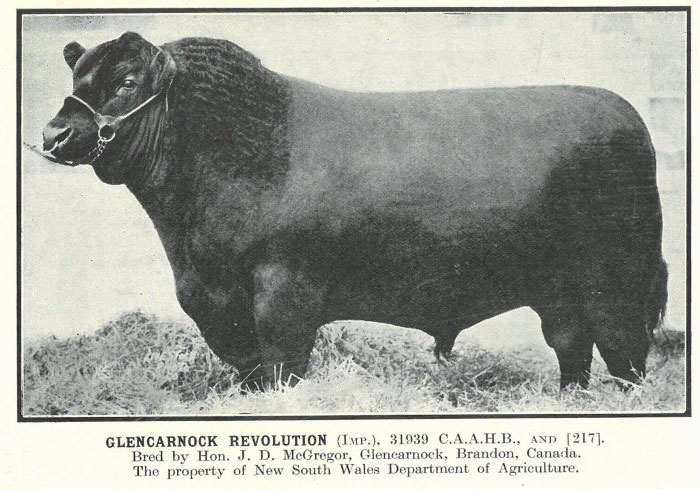
HISTORY OF AUSTRALIAN HERITAGE ANGUS CATTLE
Australian Heritage Angus cattle are cattle that have strong traceable roots to the original Scottish Aberdeen Angus. Three sources of genetics form the basis for Australian Heritage Angus. They are the Trangie descended cattle (Australian Lowline), the Irish and Scottish Native Bred Angus Cattle, and Aberdeen Angus cattle that have not had any American Angus influence since 1968 from both Australia and New Zealand.
History of the Foundation of the Trangie Angus Herd – A Unique Resource
“The Department of Agriculture (NSW) founded an Angus herd at the Agricultural Research Centre, Trangie, in 1929 to assist in the establishment and promotion of the Angus breed in the Australian cattle industry” (Parnell 1990).
The stud was founded with the importation of 21 animals from the Glencarnock stud, Brandon Canada. These consisted of two bulls, one cow and calf and seventeen heifers. These were some of the best stock that the Angus breed had to offer at the time and represented all the fashionable cow families (Canadian Aberdeen Angus Journal 1929).
The families were:
1.Blackbirds 2.Blackcaps 3.Miss Burgess 4.Georgians 5.Ericas – ( Elba, Eisa, Enchantress ) The Blackcaps and the Ericas were the dominant families imported in this shipment.
Bulls:
Glencarnoch Revolution 31939 – ( Blackcap )
Brave Edward Glencarnock 41195 – ( Blackcap (Sire)) – ( Blackbird (Dam))
Cow and Calf:
Blackcap Bixie 2nd 38527 – ( Blackcap )
Bull Calf at foot – ( Blackcap & Blackbird )
Older Heifers:
Rose of Glencarnock 2nd 39850 – ( Blackcap (Sire))
Glencarnock Elba 29th 41192 – ( Blackcap (Sire)) – ( Elba Erica (Dam))
Erica Mcgregor 2nd 39550 – ( Ericas )
Glencarnock Elba 21st 39545 – ( Blackcap ) – ( Elba Erica )
Karama of Glencarnock 4th 37755 – ( Blackcap (Sire) – ( Kindness Pride (Dam))
Glencarnock Eurotia 4th 41197 – (Eisa Erica (Dam))
Through her performances in the Trangie herd, Glencarnock Eurotia 4th certainly has been one of the most amazing cows (of any breed) ever imported into Australia. Her paternal grandsire, Eileenmere 4th was bred by J. Garrett Tolan, one of America’s true master cattle breeders. He became the key sire in Tolan’s career, being the progenitor of a long line of famous show bulls and sires (Rhodes, 1996).
Yearling Heifers:
Six yearling heifers were imported but they were not individually named by the article in the Canadian Aberdeen Angus Journal (1929). They did note that they were by Edward Glencarnock which is a Blackcap bull and the sire of the bull Brave Edward Glencarnock
Young Heifers:
There were five young heifers in the shipment they were named by the article but the Canadian Angus registration numbers were not included. They were sired by Blackcap Revolution bull so they would be from the Blackcap family through their sires and their names may give an indication of the families on their dam’s side. It is the naming convention to include part of the cow family’s name in the name of the animal or at the very least both names start with the first letter.
Kate 3rd of Page, Lady 7th of Page, Blackbird Blossom 6th of Page, Ellen E. 2nd of Page, Ellen E. 3rd of Page
Other Angus Importations to Trangie
There were several importations of bulls and heifers between 1936 and the last import in 1956. These were imported from the USA, Canada, England and Scotland.
Bulls:
Revolution of Page 28th (USA), Everside 2nd of Maisemore (England), Erison of Harvieston (Dalmeny Stud Scotland), Eblinettee’s General of Ada (Canada), Pro Ben of Balfron (140928)(Scotland)
Heifers:
Craven’s Revolution Blackcap (Canada), Lady Glencarnock 4th (Canada)
Australian animals
Between 1961 and 1964, when the herd was closed and remains so to the present day, four bulls were purchased from the four leading NSW Angus studs, Wambanumba Eclipse from the Wambanumba stud, Robert Tout Pty Ltd, Glengowan Gallant of Glengowan angus stud bred by R.P. Petallack, Tulagi Macgregor 18th from Tulagi stud bred by G.J Dohenty and Wallah Felendy of Wallah. It is interesting that the Wallah stud principle was L.T. Sanderson who was instrumental in the formation of the Red Angus breed and was one of the foundation councilors and inaugural president of the Red Angus association. It could be speculated that this is a likely source of the red genetics that we are now seeing in our breed.
References
Aberdeen Angus Journal . (March 1929). Australian Government Buys Fine Lot of Canadian Doddies. Canadian Aberdeen Angus Journal. Goodwin, S. (2012, Summer). Eye on the World Market from Angus Heart. The Land. Parnell, P. (1990, January 1). The Trangie Angus Herd – A Unique Resource. 50-53. Sanders, A. H. (n.d.). A History of Aberdeen-Angus Cattle 1860-1948.
